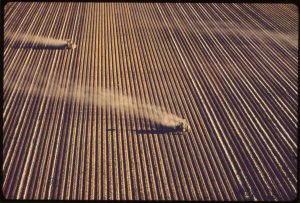 Walmart has identified fertilizer optimization as a top priority sustainability initiative this year. “Rising to the challenge of feeding 9 billion people,” their sustainability hub says, “requires the entire value chain to produce more while minimizing the impact of their actions.”
Walmart has identified fertilizer optimization as a top priority sustainability initiative this year. “Rising to the challenge of feeding 9 billion people,” their sustainability hub says, “requires the entire value chain to produce more while minimizing the impact of their actions.”
This affects farmers, certainly, but it’s not only produce suppliers who are affected by this initiative. Suppliers who rely on commodities like corn, wheat, or soy — which includes most producers of packaged foods — are expected to do their part, as well. This can be challenging, since it’s virtually impossible to trace a commodity to its home farm. GMO-free certification isn’t available for goods containing dairy products, for example, for just this reason. Tracing dairy products back to the cow and the grain that the cow ate back to the field is essentially impossible.
Walmart is hoping that getting more people along the path to take responsibility will make the whole process easier. And that’s where suppliers come in.
It may be tempting to say, “We don’t use fertilizer at all,” but if it’s anywhere in your supply chain, this applies to you. Large suppliers like Kellogg’s are leading the way by preparing Fertilizer Optimization Plans with milestones, and both Walmart and the Environmental Defense Fund would like to see more suppliers taking this action.
The business community is generally on Walmart’s side in this as well, since market-driven conservation measures are often preferred over government regulation. With many states at least discussing regulations about nutrient runoff, that may be the choice.
Fertilizer is one of the top sources of water pollution as well as one of the major expenses in modern farming. As with all Walmart’s sustainability initiatives, the object is to kill two birds with one stone, reducing costs while also working on environmental stewardship.
Overfertilized fields waste money and lead to fertilizer runoff, which is how fertilizer contributes to water pollution. Runoff can lead to algae blooms in waterways, which can in turn lead to a reduction of oxygen in the water, with predictable results for creatures living in that water. However, all fertilizer use contributes to the formation of nitrous oxide, a toxic greenhouse gas emitted by fertilized fields. Many fertilizers are created from fossil fuels, too, which are not sustainable. Reducing fertilizer use is therefore good even if overfertilization is not an issue.
Not everyone is in favor of this initiative. AGProfessional ran a commentary including phrases like “heavy-handed methods” and “a pat on the back for farmers who lick [Walmart’s] boots.”
Most commenters are seeing this as a win-win, though. Showing that agribusiness is capable of regulating itself, cutting costs, and caring for the environment are popular goals.



